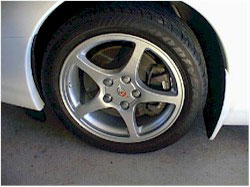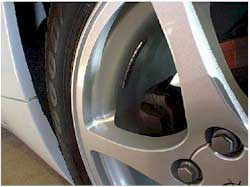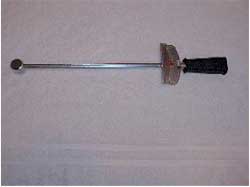Installing Y-2K Wheels on a '99 C-5
By Al Engel
It is now one year, and 7000 miles after taking delivery of my '99, Six Speed Roadster, and no, none, nada, zip problems, just high horsepower fun. To enhance the driving experience, I have done a few "improvements" that Mr. Hill and his fine team of engineers from Bowling Green overlooked. I installed:
- Corsa, touring edition, cat-back exhaust
- PFM Intake Box and K&N filter
- CAGS (Computer Aided Gear Selection) and DRL (Daytime Running Lamp) defeats
- Hard-wired, Passport Radar / Laser Detector
- Y2K, Z51 sway bars, bushings and links
- Molded and painted chip protectors on the wheel wells.
The modifications I have made have, in my opinion, improved the car and the driving experience. The Corsa exhaust, sounds great and in conjunction with the PFM intake (and a few other minor "tweaks"), allows the LS-1 to rev like an overhead cam engine, and pull hard, right to red line. Dynoed, rear wheel horsepower is coming in at 335 HP (305 RW-HP stock, out of the box from Bowling Green). Factoring in 20% power loss from the running gear, that translates to 410 HP± at the fly wheel (345 claimed stock by GM). The Z51 sway bars, installed in conjunction with the "standard" suspension, create a very agreeable ride on our rough NJ / PA roads, and improve the flat cornering characteristics and steering feel of the car tremendously. I'll do a "how to" on retro-fitting Y2K Z51 bars on earlier C5s at a later date.
There was still something missing, however. The wheels looked out of place with the delicate, but powerful lines of the ragtop C-5. The thick spoked, aluminum wheels (even chromed versions) somehow always looked out of place on the car (in my humble opinion). When the 2000 Vette came out with its new, thin spoke wheel, I knew this would produce the look I was after. So, after a few phone calls, two boxes appeared in my driveway containing a set of Y2K wheels.
With the switch to Y-2K wheels from the 97-99 versions, you need a few ancillary pieces.
- 16 wheel nuts, threaded on the outside to accept wheel nut covers
- 4 locking wheel nuts, with outside threads, for the same reason as mentioned above
- 20 wheel nut covers
- 4 center caps.
The four pressure sensing valve stems will be transferred from the old wheels to the new. New sensors go for about $137.47, each! I will keep my '99 wheels and mount a set of BFG "g-force" tires, with standard racing valves for fun'n games at the track. These are not run-flats, but hey, if you get a flat at the track, your not gonna drive at 55mph for 200 miles looking for a Goodyear dealer.
I decided I would pull the wheels off the Vette myself, and have the tires changed to the new wheels and balanced by the folks at Euro Tire in Fairfield, NJ. The wide Vette wheels, with a large negative offset, are very sensitive to precision balance. The Euro Tire guys do a fine balancing job.
We did encounter one small problem transferring the pressure sensors to the new wheels. The mounting surface for the valve / pressure sensor on the Y-2K wheels has a slight radius to it… the '97-99 wheels are machined flat in this mounting area inside the wheel. The sensor when removed from the '99 wheel had a thin, rubber "O" ring to seal it against the machined surface of the '99 wheel. An airtight seal could not be achieved on the Y-2K wheel with this thin "O" ring. Solution… take the rubber grommet from a set of racing tire valves, insert the rubber grommet (that is part of the racing valve set) into the valve stem hole in the Y-2K wheel. Then put the valve stem from the sensor through the grommet that you just inserted into the wheel. Tighten down the locking nut on the valve stem. Everything then fits very nicely, no air leaks.
Balancing was accomplished with "stick-on" (rather then clamp on) weights for aesthetic and performance purposes. No weights are visible on the outer rim, and the weight can be more precisely located to achieve better balance. Thin, stick-on weights must be used in order to retain adequate clearance between the brake caliper and the wheel. There is not too much clearance on the front wheels in this area to begin with, and adding stick on weights could cause contact with the brake caliper if care is not taken use the thin variety of stick-ons.
Mounting the new wheels on the car is a very easy process, but caution must be exercised in tightening the wheel nuts. Most tire shops will just "hit 'em with the air gun", and you will probable experience the feeling of brake disk warpage in about 5000 to 7000 miles. GM brake disks are very susceptible to lateral run-out variation (rotor warpage). In most cases, uneven tightening of wheel nuts causes this problem. Because the problem does not manifest itself as a pulsating brake pedal for about 5 to 7 thousand miles after the improper tightening event, most folks do not associate the problem with the cause. For this reason, I never let anyone put a wheel on any of my cars. I always do it myself, with the proper cris-cross tightening pattern, tightening the nuts in three stages… 50% of final torque, 80% , then finally 100% (100 ft-lbs. for the C-5 lugs), clean and dry… no anti-seize compound on the lug nuts…. unless you are mounting Magnesium wheels. I recommend a "dial-in" torque wrench, rather than a "dial and pointer" type. The less expensive, dial and dointer torque wrench has to be viewed and read as torque is being applied…. impossible to do in many situations. The dial-in type, you simply dial-in the desired torque, and use the wrench. When you reach the desired torque level, the wrench makes an audible (and you can feel it) "click"…. and you know you are at the desired level of tightness (a.k.a. torque).
Now, screw on the wheel nut caps (finger tight), pop in the center caps, check tire pressure with the tires loaded with the weight of the car (I use 32 lbs., front and 30 lbs. in the rears). Time for a road test….. 30 MPH, no vibration, 50MPH no vibration, 65MPH no vibration, and so on…… (no self-incriminating statements in this story).
The Y2K wheels are considerably lighter then the '97-'99 wheels. In fact, the Y2Ks are even lighter than the very expensive Magnesium wheels. The Y2K aluminum wheels yields a total weight savings of 25.72lbs as compared to the stock '97-'99 wheels, and are about 12lbs lighter for all four wheels than the Magnesium wheel set! This produces a significant reduction in "un-sprung" weight, and should result in better, rough road handling. I'll let you know if I see an appreciable difference in this regard after I get the car onto some of my favorite Pennsylvania back road twisties this springtime.
Bottom line, I think the car looks better, I now have a spare set of "Track Wheels", and I have taken 25lbs. off the car, all of it on the working part of the suspension. Not bad for an afternoon's work, in the winter, in a heated garage, dreaming about top down driving, still months away.



